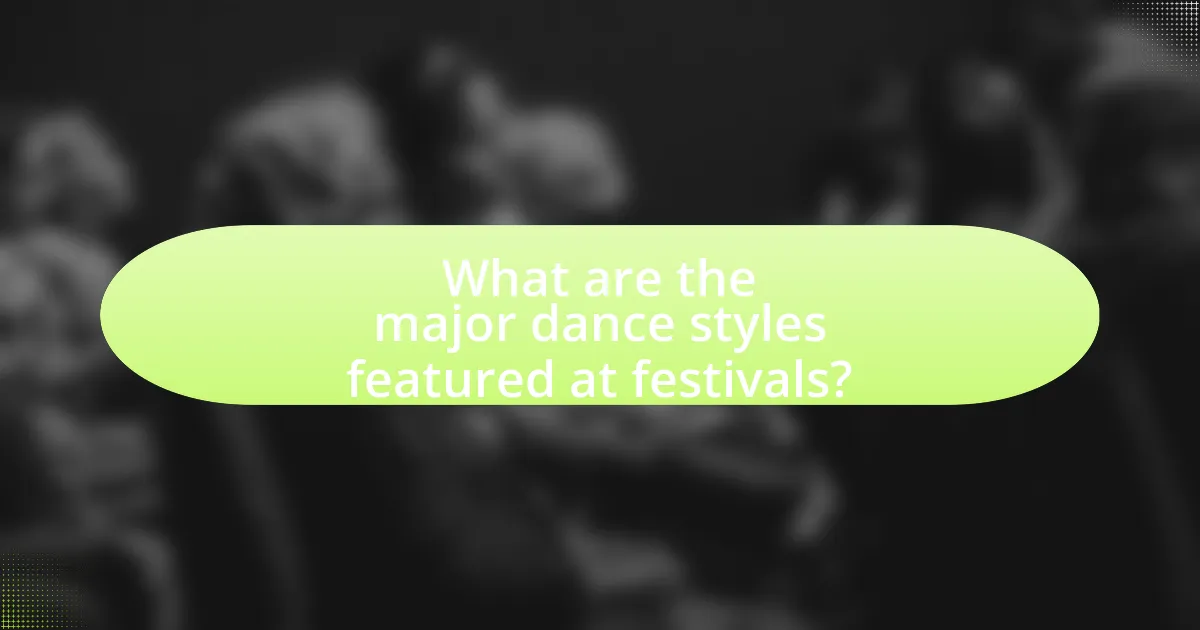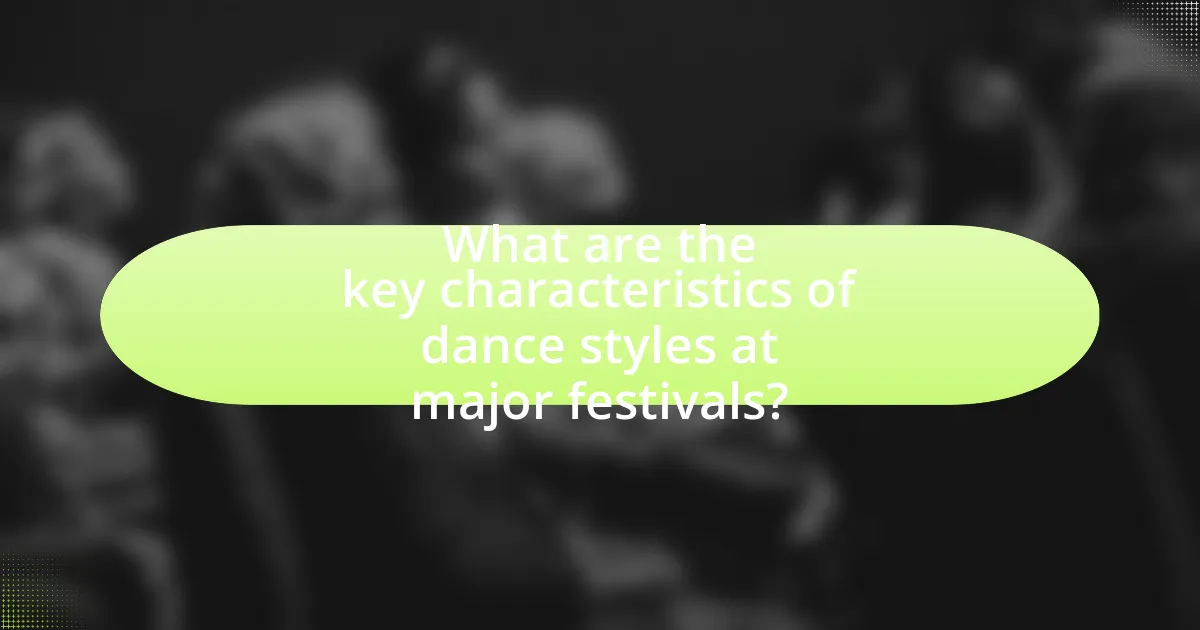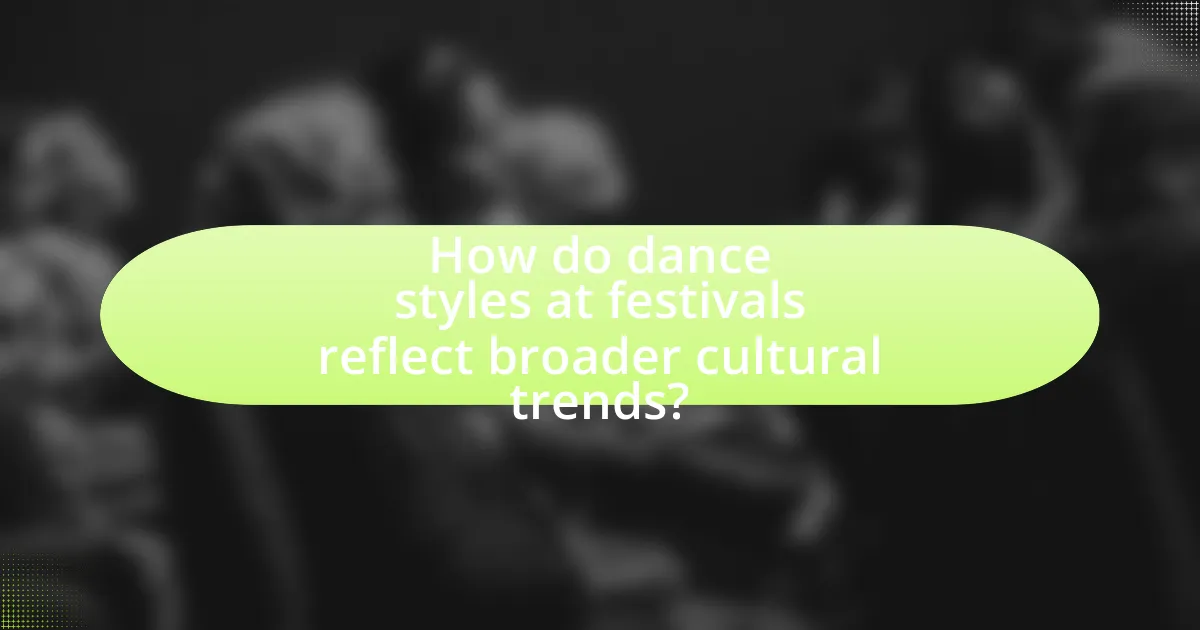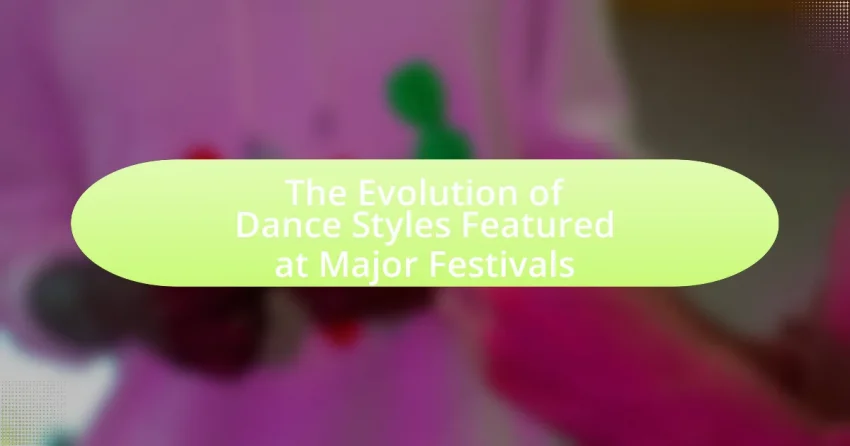The article focuses on the evolution of dance styles featured at major festivals, highlighting key genres such as electronic dance, hip-hop, salsa, ballet, and traditional folk dances. It examines how these styles have transformed over time due to cultural exchanges, technological advancements, and social movements, while also addressing the historical influences that have shaped them. Additionally, the article discusses the importance of festivals in promoting dance culture, the impact of audience engagement on the popularity of dance styles, and the challenges dancers face in festival environments. It further explores the role of technology and social media in shaping dance trends, as well as best practices for dancers to enhance their visibility and performance quality at these events.

What are the major dance styles featured at festivals?
Major dance styles featured at festivals include electronic dance, hip-hop, salsa, ballet, and traditional folk dances. Electronic dance music festivals prominently showcase styles like house, techno, and trance, attracting large crowds and fostering vibrant dance cultures. Hip-hop dance, characterized by its street style and improvisation, is often highlighted in urban festivals, reflecting contemporary trends. Salsa, with its Latin roots, is celebrated in cultural festivals, promoting social dancing and community engagement. Ballet, while less common, can be featured in classical music festivals, showcasing its artistic expression. Traditional folk dances represent cultural heritage at various regional festivals, preserving historical dance forms and fostering community identity.
How have these dance styles evolved over time?
Dance styles have evolved significantly over time, influenced by cultural shifts, technological advancements, and social movements. For instance, hip-hop emerged in the 1970s as a form of expression for marginalized communities in the Bronx, New York, and has since transformed into a global phenomenon, incorporating elements from various genres and adapting to contemporary issues. Similarly, electronic dance music (EDM) styles have evolved from disco in the 1970s to a diverse range of sub-genres today, driven by advancements in music production technology and the rise of festival culture. These changes reflect broader societal trends, such as the increasing globalization of music and dance, which has led to cross-cultural collaborations and the blending of traditional and modern styles.
What historical influences have shaped these dance styles?
Historical influences that have shaped dance styles featured at major festivals include cultural exchanges, social movements, and historical events. For instance, the African diaspora significantly impacted the development of jazz and hip-hop dance, as enslaved Africans brought their rhythmic traditions to America, blending them with European styles. Additionally, the civil rights movement in the 1960s inspired dance forms like the twist and the hustle, reflecting societal changes and the quest for freedom. Furthermore, the globalization of culture has led to the fusion of various dance styles, such as the incorporation of Latin rhythms into contemporary dance, showcasing the influence of international music and dance trends. These historical contexts provide a framework for understanding the evolution of dance styles at festivals.
How do cultural exchanges impact the evolution of dance styles?
Cultural exchanges significantly influence the evolution of dance styles by facilitating the blending of diverse movements, techniques, and traditions. For instance, the introduction of African rhythms and movements into American dance forms during the transatlantic slave trade led to the development of jazz and tap dance. This blending is evident in major festivals where various cultural dance styles are showcased, allowing for cross-pollination of ideas and practices. Historical examples include the integration of Latin dance styles into ballroom dancing, which transformed social dance in the 20th century. Such exchanges not only enrich the dance repertoire but also reflect the social and political dynamics of the time, demonstrating how cultural interactions shape artistic expression.
Why are festivals important for showcasing dance styles?
Festivals are important for showcasing dance styles because they provide a platform for diverse cultural expressions and foster community engagement. Major festivals often feature a variety of dance forms, allowing artists to present their work to a broader audience, which enhances visibility and appreciation for different styles. For instance, events like the Edinburgh Festival Fringe and the Jacob’s Pillow Dance Festival have historically highlighted both traditional and contemporary dance, attracting thousands of attendees and promoting cultural exchange. This exposure not only supports artists but also educates audiences about the richness of global dance traditions, thereby preserving and evolving these art forms.
What role do festivals play in the promotion of dance culture?
Festivals play a crucial role in the promotion of dance culture by providing a platform for diverse dance styles to be showcased and celebrated. These events attract large audiences, which fosters community engagement and appreciation for various forms of dance. For instance, major festivals like the Edinburgh Festival Fringe and the Dance on Camera Festival feature performances from both established and emerging artists, allowing for cultural exchange and innovation in dance. Additionally, research indicates that participation in dance festivals can enhance cultural identity and social cohesion, as seen in studies conducted by the University of California, which highlight the positive impact of such events on local communities.
How do audiences influence the popularity of dance styles at festivals?
Audiences significantly influence the popularity of dance styles at festivals by actively participating in and shaping the cultural landscape of these events. Their preferences and engagement determine which dance styles gain traction, as seen in the rise of electronic dance music (EDM) and its associated dance forms, which became mainstream largely due to audience enthusiasm and social media sharing. For instance, the popularity of styles like twerking and shuffle dancing surged at festivals like Coachella and Tomorrowland, driven by audience participation and viral trends. This dynamic interaction between audiences and performers creates a feedback loop, where the visibility and acceptance of certain dance styles are amplified, leading to their increased popularity at festivals.

What are the key characteristics of dance styles at major festivals?
Dance styles at major festivals are characterized by their cultural diversity, energetic expression, and audience engagement. These styles often reflect the cultural heritage of the regions they represent, incorporating traditional movements and music that resonate with local customs. For example, festivals like Carnival in Brazil showcase samba, which is known for its rhythmic, fast-paced footwork and vibrant costumes, while the Edinburgh Festival features Scottish Highland dancing, emphasizing precision and athleticism. Additionally, many dance styles at festivals prioritize audience participation, encouraging spectators to join in, which enhances the communal experience. This interactive element is evident in events like the Holi Festival in India, where traditional folk dances invite everyone to celebrate together.
How do different genres of music influence dance styles?
Different genres of music significantly influence dance styles by dictating rhythm, tempo, and emotional expression. For instance, hip-hop music, characterized by its strong beats and syncopation, encourages dynamic and improvisational dance styles such as breakdancing and locking. In contrast, classical music, with its structured compositions and varying tempos, inspires more formal and graceful dance forms like ballet. Additionally, electronic dance music (EDM) promotes energetic and repetitive movements, leading to styles like shuffle dancing and rave culture. Historical context supports this, as the emergence of jazz music in the early 20th century gave rise to swing dancing, showcasing how musical evolution directly shapes dance forms.
What are the common movements associated with popular festival dance styles?
Common movements associated with popular festival dance styles include rhythmic footwork, body isolations, and expressive arm movements. For instance, in styles like salsa, dancers often perform quick foot shuffles and spins, while in hip-hop, body isolations and popping are prevalent. Additionally, traditional folk dances often incorporate group formations and synchronized movements, reflecting cultural heritage. These movements are integral to the dance styles, enhancing the festive atmosphere and engaging participants.
How do visual elements enhance the experience of dance at festivals?
Visual elements significantly enhance the experience of dance at festivals by creating an immersive atmosphere that captivates audiences. These elements, such as lighting, stage design, and visual projections, complement the choreography and music, making performances more engaging. For instance, studies show that synchronized lighting effects can increase audience emotional responses, leading to a more memorable experience. Additionally, vibrant costumes and visual art installations contribute to the overall aesthetic, reinforcing the cultural themes of the dance styles being showcased. This combination of visual stimulation and dance not only entertains but also deepens the audience’s connection to the performance, making it a holistic experience.
What are the social and community aspects of dance at festivals?
Dance at festivals serves as a vital social and community connector, fostering interaction and shared experiences among attendees. This communal aspect is evident as participants engage in collective movement, which promotes unity and cultural expression. Research indicates that dance facilitates social bonding, with studies showing that group dancing can enhance feelings of belonging and community cohesion. For instance, a study published in the Journal of Community Psychology highlights how dance events contribute to social networks and community identity, reinforcing the idea that festivals are not just entertainment but also vital social gatherings that strengthen community ties.
How do dance styles foster community engagement at festivals?
Dance styles foster community engagement at festivals by creating shared experiences that encourage participation and interaction among attendees. These styles often incorporate elements that invite audience involvement, such as group dances or workshops, which promote social bonding. For instance, traditional folk dances often reflect cultural heritage and invite community members to join in, reinforcing a sense of belonging and identity. Research indicates that festivals featuring interactive dance elements see higher levels of attendee satisfaction and community cohesion, as participants feel more connected to both the event and each other.
What are the collaborative opportunities for dancers at festivals?
Collaborative opportunities for dancers at festivals include workshops, performances, and networking events. Workshops allow dancers to learn from each other and from experienced instructors, fostering skill development and creative exchange. Performances often feature collaborative pieces where dancers from different backgrounds come together to create unique routines, showcasing diverse styles. Networking events provide a platform for dancers to connect with choreographers, producers, and other artists, leading to potential collaborations beyond the festival. These opportunities enhance artistic growth and promote the evolution of dance styles within the festival environment.

How do dance styles at festivals reflect broader cultural trends?
Dance styles at festivals reflect broader cultural trends by serving as a mirror of societal values, influences, and changes. For instance, the rise of electronic dance music (EDM) festivals in the 2010s showcased a shift towards digital culture and community-driven experiences, emphasizing inclusivity and self-expression. This trend aligns with the increasing acceptance of diverse identities and the blending of global cultures, as seen in the incorporation of various international dance forms like Afrobeat and K-pop into mainstream festival lineups. Additionally, the resurgence of traditional dance styles at festivals highlights a cultural nostalgia and a desire to reconnect with heritage, indicating a broader societal movement towards valuing authenticity and cultural roots.
What current trends are influencing the evolution of dance styles?
Current trends influencing the evolution of dance styles include the integration of technology, the rise of social media platforms, and the blending of cultural influences. Technology, such as augmented reality and virtual reality, enhances performances and creates immersive experiences, as seen in major festivals like Coachella. Social media platforms, particularly TikTok, have popularized dance challenges, leading to the rapid dissemination of new styles and moves, which influences mainstream dance culture. Additionally, the blending of cultural influences, driven by globalization, allows for the fusion of traditional and contemporary styles, exemplified by the incorporation of hip-hop elements into ballet and contemporary dance. These trends collectively shape the dynamic landscape of dance today.
How does technology impact dance performances at festivals?
Technology significantly enhances dance performances at festivals by integrating advanced audiovisual elements, interactive experiences, and real-time data analytics. For instance, the use of LED screens and projection mapping creates immersive environments that elevate the visual appeal of performances, allowing choreographers to synchronize movements with dynamic visuals. Additionally, wearable technology enables dancers to monitor their physical performance metrics, improving their technique and audience engagement. Research from the University of California, Irvine, highlights that incorporating technology in dance can increase audience retention and emotional connection, demonstrating its effectiveness in enhancing the overall festival experience.
What role does social media play in shaping dance trends at festivals?
Social media significantly influences dance trends at festivals by facilitating rapid dissemination and visibility of new styles. Platforms like Instagram, TikTok, and YouTube allow dancers and choreographers to showcase their moves to a global audience, leading to viral trends that can quickly become popular at live events. For instance, the “Renegade” dance became a sensation on TikTok, prompting its widespread adoption at various music festivals. This phenomenon illustrates how social media acts as a catalyst for the evolution of dance styles, enabling real-time sharing and adaptation of choreography among festival-goers.
What challenges do dance styles face in the festival environment?
Dance styles face several challenges in the festival environment, including limited space, diverse audience expectations, and competition from other performances. Limited space can restrict the movement and expression of dancers, impacting the overall presentation of their style. Diverse audience expectations require dancers to adapt their performances to cater to varying tastes, which can dilute the authenticity of specific dance styles. Additionally, competition from other performances can overshadow certain dance styles, making it difficult for them to gain visibility and appreciation. These challenges can hinder the representation and evolution of dance styles at festivals.
How do dancers adapt to changing audience expectations at festivals?
Dancers adapt to changing audience expectations at festivals by incorporating contemporary trends and audience feedback into their performances. This adaptability is evident as dancers often analyze social media reactions and audience demographics to tailor their routines, ensuring relevance and engagement. For instance, festivals like Coachella have seen dancers integrate popular music styles and cultural elements that resonate with diverse audiences, reflecting a shift towards inclusivity and innovation in dance. This responsiveness not only enhances audience satisfaction but also fosters a dynamic environment where dance styles evolve in real-time, aligning with the festival’s overall theme and audience interests.
What are the sustainability issues related to dance performances at festivals?
Sustainability issues related to dance performances at festivals include environmental impact, resource consumption, and waste generation. Dance festivals often require significant energy for lighting, sound, and staging, contributing to carbon emissions. Additionally, the use of materials for costumes and set designs can lead to resource depletion and pollution. According to a study by the Green Music Initiative, events can produce up to 1,000 tons of waste, highlighting the need for better waste management practices. Furthermore, the transportation of performers and equipment adds to the carbon footprint, necessitating a focus on sustainable travel options.
What are some best practices for dancers participating in festivals?
Dancers participating in festivals should prioritize preparation, professionalism, and adaptability. Preparation involves rehearsing thoroughly to ensure confidence and skill during performances, as well as understanding the festival’s schedule and requirements. Professionalism is crucial; dancers should arrive on time, dress appropriately, and maintain a positive attitude, which reflects well on themselves and their group. Adaptability is essential in a festival environment, where unexpected changes may occur, such as schedule shifts or technical issues. Dancers should be ready to adjust their routines or collaborate with other performers, enhancing the overall festival experience. These best practices contribute to successful performances and foster a positive atmosphere at dance festivals.
How can dancers prepare for performances at major festivals?
Dancers can prepare for performances at major festivals by engaging in rigorous training, developing a strong understanding of the festival’s theme, and rehearsing extensively with their dance group. Rigorous training enhances physical endurance and technical skills, which are crucial for high-energy performances often seen at festivals. Understanding the festival’s theme allows dancers to tailor their choreography and costumes to align with the event’s overall aesthetic, ensuring a cohesive presentation. Extensive rehearsals with the dance group foster teamwork and synchronization, which are essential for delivering a polished performance. These preparation strategies are supported by the fact that successful festival performances often require a combination of technical skill, thematic relevance, and group cohesion, as evidenced by numerous case studies of acclaimed dance troupes at major events.
What strategies can enhance the visibility of dance styles at festivals?
To enhance the visibility of dance styles at festivals, organizers can implement targeted marketing campaigns that showcase diverse dance forms through social media, workshops, and live performances. For instance, utilizing platforms like Instagram and TikTok can attract younger audiences by featuring short, engaging videos of dance styles, which can increase interest and attendance. Additionally, offering interactive workshops allows festival-goers to experience the dance styles firsthand, fostering a deeper appreciation and understanding. Research indicates that festivals that incorporate educational components, such as dance classes or demonstrations, see a 30% increase in participant engagement, thereby enhancing visibility and interest in various dance styles.
